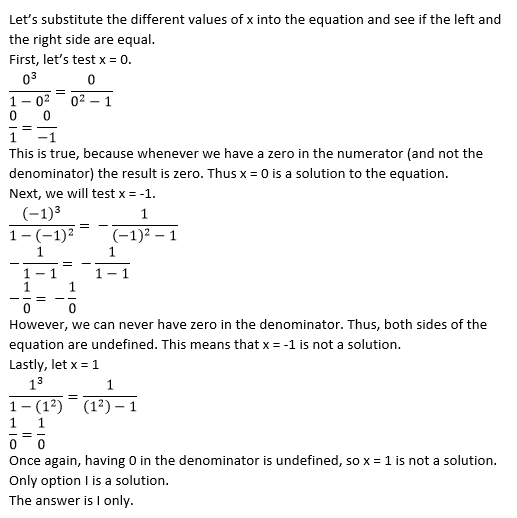All GRE Math Resources
Example Questions
Example Question #1 : Equations / Inequalities
Quantity A:
Quantity B:
The two quantities are equal.
The relationship cannot be determined from the information given.
Quantity B is greater.
Quantity A is greater.
The relationship cannot be determined from the information given.
We are given that y = 32. Plug this value of y into the second equation.
32 = x2 – 4
36 = x2
x = +/– 6.
Next find a value for Quantity A:
y/7 = 32/7
This number is less than +6, but more than –6. Thus, the relationship cannot be determined from the information given.
Example Question #2 : Equations / Inequalities
Column A: 
Column B:
The relationship cannot be determined.
The values are equal.
Column B is greater.
Column A is greater.
The relationship cannot be determined.
Column B is greater for positive numbers.
The columns are equal for 0.
Column A is greater for negative numbers.
Because our answer changes depending on the value inserted, we cannot determine the relationship.
Example Question #41 : Gre Quantitative Reasoning
Find the solution to the following equation if x = 3:
y = (4x2 - 2)/(9 - x2)
6
0
no possible solution
3
no possible solution
Substituting 3 in for x, you will get 0 in the denominator of the fraction. It is not possible to have 0 be the denominator for a fraction so there is no possible solution to this equation.
Example Question #42 : Gre Quantitative Reasoning
I. x = 0
II. x = –1
III. x = 1
I, II, and III
I only
II and III only
II only
III only
I only
Example Question #2 : How To Find Out When An Equation Has No Solution
–1/2
There is no solution
1
3
–3
There is no solution
Example Question #43 : Gre Quantitative Reasoning

None of the other answers
A fraction is considered undefined when the denominator equals 0. Set the denominator equal to zero and solve for the variable.
Example Question #141 : Linear / Rational / Variable Equations
Solve:
First, distribute, making sure to watch for negatives.
Combine like terms.
Subtract 7x from both sides.
Add 18 on both sides and be careful adding integers.
Example Question #3 : Equations / Inequalities
Solve:
No Solution
Infinitely Many Solutions
No Solution
First, distribute the 
Add 6x to both sides.
This is false for any value of 
Example Question #1 : Linear / Rational / Variable Equations
Solve 
No solutions
No solutions
By definition, the absolute value of an expression can never be less than 0. Therefore, there are no solutions to the above expression.
Example Question #3 : Equations / Inequalities
Quantity A:
Quantity B: 11
The two quantities are equal.
The relationship cannot be determined.
Quantity B is greater
Quantity A is greater
Quantity B is greater
Expand 

Since 

All GRE Math Resources

















































